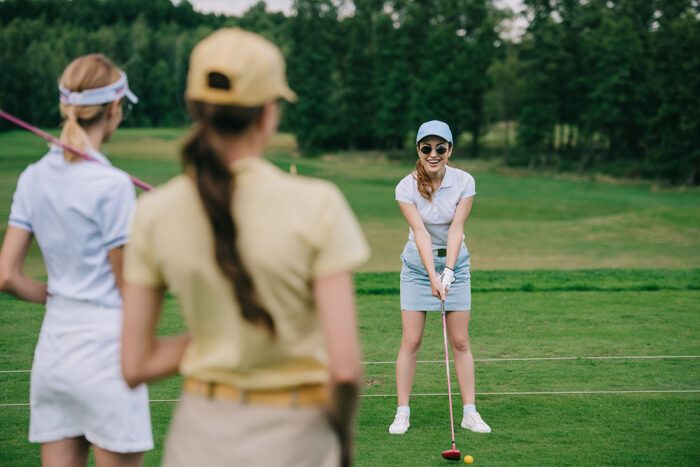LPGA Master Instructor Kiran Kanwar PhD welcomes the huge growth in the number of women playing golf over the past three years, but asks a key question: how long will they continue playing?
Are women in general interested in golf? How many women currently practice this sport? An answer can be found in the many organizations that track golfer numbers. For example, data shows that 20% of the UK’s 5.6 million golfers in 2022 were women.
According to the U.S. National Golf Foundation, around the same time, 25 percent of golfers on the course were women, up from 19 percent a decade ago.
This increase is likely due, in large part, to the dozens of organizations that have sprung up around the world as stakeholders realize the monetary benefits of including women to support golf’s often fluctuating fortunes. Interestingly, the growth is skewed toward entry-level golfers (41 percent of whom are women), juniors (37 percent) and off-course players (41 percent).
While the growing number of women playing golf is indeed encouraging and paints a very promising picture, with more and more women taking up golf, especially since the pandemic, few are addressing the elephant in the room. the room. That of how long women actually stay in the sport, and whether female golfers are dropping out of the sport and why.

To find numbers on this topic, one must consult a nearly 20-year-old article on the golf course industry, “Why They Quit the Game,” published in 2004. It only discusses the subject of golfers in general , and not the golfers in particular. He points out that if three million people enter the game each year (in the United States), three million also exit. The article adds that the three big myths surrounding why golfers give up the game are that it is difficult to get a tee time, that it costs too much, and that it takes too long. According to the author, the main reason golfers give up is that many golf courses are too difficult.
“Why women choose not to play golf” is the title of an article that could shed some light on the question, especially since it is written by a female author (Jenn Harris in an article on LinkedIn). According to her, some of the aspects of the game that could deter women are: “People are too arrogant at the clubs, they feel like no man will want to play golf with them, because they think that ‘They won’t be good enough. and because it takes too long to play the game. Oh, and it’s also very expensive. She believes women should be convinced of the benefits of golf, such as good weather and daily step count. These solutions are perhaps generation-specific and speak more to baby boomer women than to millennials and Gen Z, who know their own worth and won’t be put off by arrogant or disinterested club members.
A new online platform serving the hospitality sector (lightspeedhq.com) suggests various ideas centered around the theme of organizing golf days and group golf lessons for women and girls and ensuring they receive discounts. Surely these are ideas that golf courses have already considered or even implemented for years?
In the United States, the National Women’s Golf Alliance inspects golf courses to determine whether they are suitable for women and rates them based on course playability, level of hospitality, and their women’s-specific golf programs. It is not known if this organization still exists, with a website that does not work. However, the many ideas of its founders are well thought out and worth checking out (visit golfdom.com).
Here are some powerful suggestions for golf course owners and managers who really care about increasing the number of female golfers at their facilities:
First, know the generational and socioeconomic demographics of the females you want to recruit to golf. Are you likely to offer quick golf with music, food and a party atmosphere? Otherwise, your best target audience is baby boomer women. Three things will help the most (besides lower prices, clean toilets, and women’s preferred food choices, which should be a no-brainer).
1. Adapt your course to the needs of your potential and existing golfers. Not just in the event with advanced tees, less forced carries, doglegs and fairways that slope towards advantageous locations. Specifically, you could offer a day of free individual golf lessons to local female golfers. Your club professional may receive a simple questionnaire to complete.

The professional would measure, on a sophisticated launch monitor, 15 tee shots and 15 fairway shots with each golfer’s preferred club for each shot. Learn your specific population’s distance and directional dispersion patterns, their carry and trajectory capabilities, then hire a golf course architect who can modify elements of your course to make it truly relevant to your golfers.
2. Find a good club fitter who can put together a set for any golfer that is both brand and gender independent and doesn’t break the bank to acquire it. Why did equipment manufacturers unilaterally decide that all women golfers needed drivers and 15° irons, lots of wedges, and pretty pastel colors to put it all together?
3. Teach them a body-friendly women’s golf swing. While women are generally very flexible, the more they move, particularly in the legs, torso and head, the less likely they are to make authoritative enough contact with the ball consistently to achieve significant trajectory and therefore a great distance. What women need is a very still body and arms with a wide arc, both of which have been studied to allow female golfers to fly the ball better.
It is possible to attract many more female golfers to the game, but it requires much more than the sometimes superficial and very stereotypical solutions that have typically been proposed over the years.
LPGA Master Instructor Kiran Kanwar has a doctorate in kinesiology (biomechanics and anatomy) and has written a thesis on the causes of golf swing injuries. Kiran also serves as chair of the golf department at Stanton University. Visit his website www.YourGolfGuru.com

